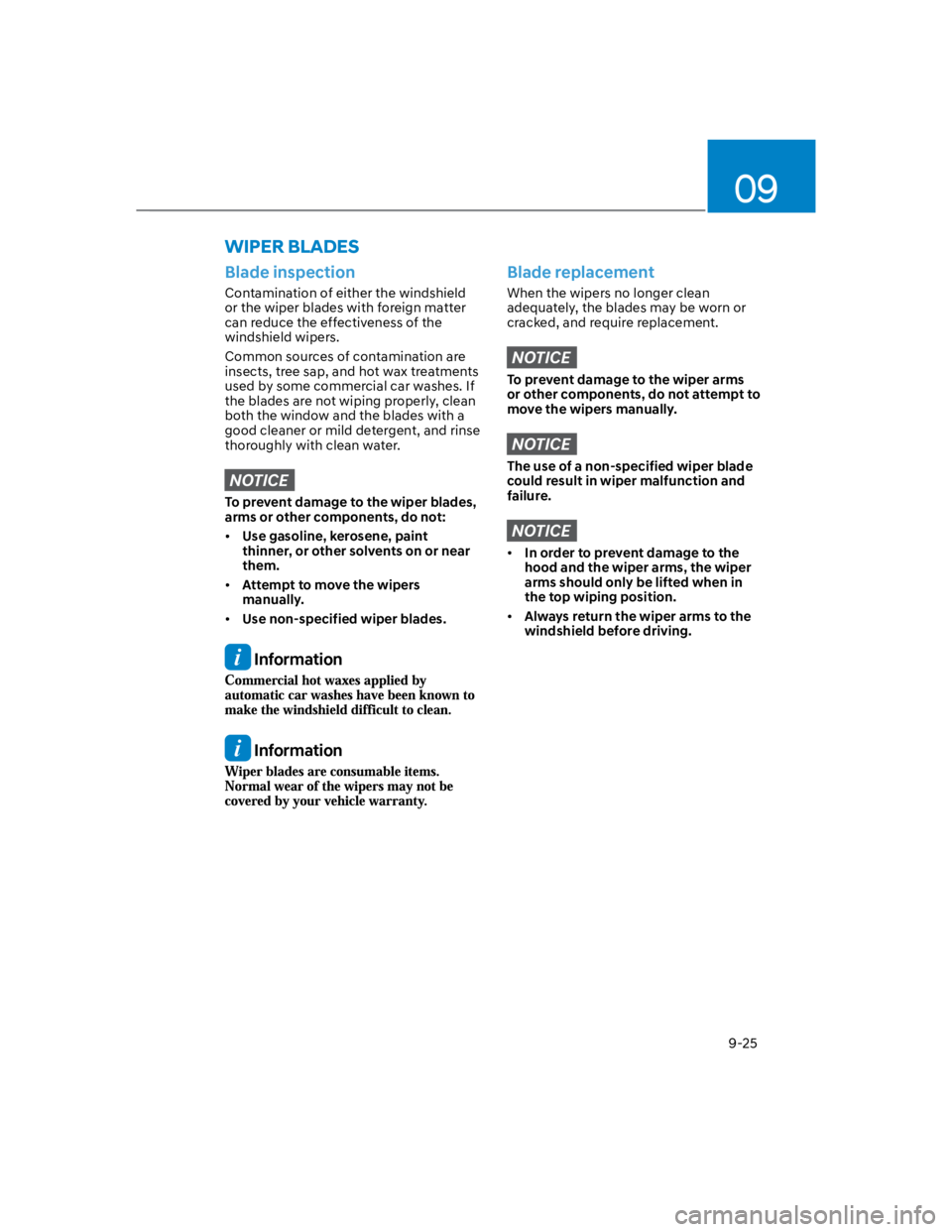2022 HYUNDAI KONA windshield wiper
[x] Cancel search: windshield wiperPage 354 of 579

Driver assistance system
7-22
WARNING
Even though the warning message or
warning light does not appear on the
cluster, Forward Collision-Avoidance
Assist may not properly operate.
Forward Collision-Avoidance Assist
may not properly operate in an
area (e.g. open terrain), where any
substance are not detected after
turning ON the engine.
Limitations of Forward Collision-
Avoidance Assist
Forward Collision-Avoidance Assist may
not operate normally, or it may operate
unexpectedly under the following
circumstances:
The detecting sensor or the
surroundings are contaminated or
damaged
The temperature around the front
view camera is high or low
The camera lens is contaminated due
to tinted, filmed or coated windshield,
damaged glass, or sticky foreign
material (sticker, bug, etc.) on the
glass
Moisture is not removed or frozen on
the windshield
Washer fluid is continuously sprayed,
or the wiper is on
Driving in heavy rain or snow, or thick
fog
The field of view of the front view
camera is obstructed by sun glare
Street light or light from an oncoming
vehicle is reflected on the wet road
surface, such as a puddle on the road
An object is placed on the dashboard
Your vehicle is being towed
The surrounding is very bright
The surrounding is very dark, such as
in a tunnel, etc.
The brightness changes suddenly, for
example when entering or exiting a
tunnel
The brightness outside is low, and the
headlamps are not on or are not bright
Driving through steam, smoke or
shadow
Only part of the vehicle, pedestrian or
cyclist is detected
The vehicle in front is a bus, heavy
truck, truck with a unusually shaped
luggage, trailer, etc.
The vehicle in front has no tail lights,
tail lights are located unusually, etc.
The brightness outside is low, and the
tail lamps are not on or are not bright
The rear of the front vehicle is small
or the vehicle does not look normal,
such as when the vehicle is tilted,
overturned, or the side of the vehicle
is visible, etc.
low or high
A vehicle, pedestrian or cyclist
suddenly cuts in front
The bumper around the front radar is
impacted, damaged or the front radar
is out of position
The temperature around the front
radar is high or low
Page 407 of 579

07
7-75
Smart Cruise Control disabled
OTM070115N
When the front radar cover or sensor
is covered with snow, rain, or foreign
material, it can reduce the detecting
performance and temporarily limit or
disable Smart Cruise Control.
If this occurs the ‘Smart Cruise Control
message will appear for a certain period
of time on the cluster.
Smart Cruise Control will operate
normally when snow, rain or foreign
material is removed.
CAUTION
Even though the warning message does
not appear on the cluster, Smart Cruise
Control may not properly operate.
CAUTION
Smart Cruise Control may not properly
operate in an area (e.g. open terrain),
where there is nothing to detect after
turning ON the engine.
Limitations of Smart Cruise Control
Smart Cruise Control may not operate
normally, or it may operate unexpectedly
under the following circumstances:
The detecting sensor or the
surroundings are contaminated or
damaged
Washer fluid is continuously sprayed,
or the wiper is on
The camera lens is contaminated due
to tinted, filmed or coated windshield,
damaged glass, or sticky foreign
material (sticker, bug, etc.) on the
glass
Moisture is not removed or frozen on
the windshield
The field of view of the front view
camera is obstructed by sun glare
Street light or light from an oncoming
vehicle is reflected on the wet road
surface, such as a puddle on the road
The temperature around the front
view camera is high or low
An object is placed on the dashboard
The surrounding is very bright
The surrounding is very dark, such as
in a tunnel, etc.
The brightness changes suddenly, for
example when entering or exiting a
tunnel
The brightness outside is low, and the
headlamps are not on or are not bright
Driving in heavy rain or snow, or thick
fog
Driving through steam, smoke or
shadow
Page 492 of 579

Maintenance
9-6
Owner maintenance schedule
When you stop for fuel:
Check the coolant level in the engine
coolant reservoir or the water-cooled
intercooler coolant reservoir.
Check the windshield washer fluid
level.
Check for low or under-inflated tires.
WARNING
Be careful when checking your coolant
level when the engine is hot. This may
result in coolant being blown out of the
opening and cause serious burns and
other injuries.
While operating your vehicle:
Note any changes in the sound of the
exhaust or any smell of exhaust fumes
in the vehicle.
Check for vibrations in the steering
wheel. Notice if there is any increased
steering effort or looseness in the
steering wheel, or change in its
straight-ahead position.
Notice if your vehicle constantly turns
slightly or “pulls” to one side when
traveling on smooth, level road.
When stopping, listen and check for
unusual sounds, pulling to one side,
increased brake pedal travel or “hard-
to-push” brake pedal.
If any slipping or changes in the
operation of your transmission occurs,
check the transmission fluid level.
Check the automatic transmission P
(Park) function.
Check the parking brake.
Check for fluid leaks under your
vehicle (water dripping from the air
conditioning system during or after
use is normal).
At least monthly:
Check coolant level in the engine
coolant reservoir.
Check the operation of all exterior
lights, including the stoplights, turn
signals and hazard warning flashers.
Check the inflation pressures of all
tires including the spare for tires that
are worn, show uneven wear, or are
damaged.
Check for loose wheel lug nuts.
At least twice a year: (i.e., every
Spring and Autumn)
Check radiator, heater and air
conditioning hoses for leaks or
damage.
Check windshield washer spray and
wiper operation. Clean wiper blades
with a clean cloth dampened with
washer fluid.
Check headlamp alignment.
Check muffler, exhaust pipes, shields
and clamps.
Check the seat belts for wear and
function.
At least once a year:
Clean body and door drain holes.
Lubricate door hinges and hood
hinges.
Lubricate door and hood locks and
latches.
Lubricate door rubber weather strips.
Check the air conditioning system.
Inspect and lubricate automatic
transmission linkage and controls.
Clean the battery and terminals.
Check the brake fluid level.
Page 511 of 579

09
9-25
Blade inspection
Contamination of either the windshield
or the wiper blades with foreign matter
can reduce the effectiveness of the
windshield wipers.
Common sources of contamination are
insects, tree sap, and hot wax treatments
used by some commercial car washes. If
the blades are not wiping properly, clean
both the window and the blades with a
good cleaner or mild detergent, and rinse
thoroughly with clean water.
NOTICE
To prevent damage to the wiper blades,
arms or other components, do not:
Use gasoline, kerosene, paint
thinner, or other solvents on or near
them.
Attempt to move the wipers
manually.
Use non-specified wiper blades.
Information
Information
Blade replacement
When the wipers no longer clean
adequately, the blades may be worn or
cracked, and require replacement.
NOTICE
To prevent damage to the wiper arms
or other components, do not attempt to
move the wipers manually.
NOTICE
The use of a non-specified wiper blade
could result in wiper malfunction and
failure.
NOTICE
In order to prevent damage to the
hood and the wiper arms, the wiper
arms should only be lifted when in
the top wiping position.
Always return the wiper arms to the
windshield before driving.
WIPER BLADES
Page 512 of 579

Maintenance
9-26
Front windshield wiper blade
replacement
OGSR076067
Type A
1. Put the front windshield wipers into
the service position.
2. Raise the wiper arm and slightly rotate
the wiper blade assembly to expose
the plastic locking clip.
NOTICE
Do not allow the wiper arm to fall
against the windshield, since it may
chip or crack the windshield.
OGSR076066
OGSR076068
3. Press the clip (1) and slide the blade
assembly downward (2).
4. Lift it off the arm.
5. Install the blade assembly in the
reverse order of removal.
6. Return the wiper arm on the
windshield.
Page 513 of 579

09
9-27
OLF074017
Type B
1. Raise the wiper arm.
NOTICE
Do not allow the wiper arm to fall
against the windshield, since it may
chip or crack the windshield.
OLF074018
OLF074019
2. Lift up the wiper blade clip (1). Then
pull down the blade assembly (2) and
remove it.
3. Install the new blade assembly in the
reverse order of removal.
4. Return the wiper arm on the
windshield.
Page 579 of 579

I
I-13
V
Vehicle break-in process ........................................................................................ 1-7
Vehicle certification label .................................................................................... 2-15
Vehicle data collection and event data recorders ................................................... 1-8
Vehicle Identification Number (VIN) .................................................................. 2-15
Vehicle load limit ................................................................................................. 6-70
The Loading Information Label ....................................................................... 6-71
Vehicle modifications ............................................................................................ 1-7
Volume and weight .............................................................................................. 2-12
W
Washer fluid ......................................................................................................... 9-22
Checking the washer fluid level ....................................................................... 9-22
Windows .............................................................................................................. 5-53
Power Windows................................................................................................ 5-54
Windshield defrosting and defogging.................................................................. 5-98
Auto defogging system (only for automatic climate control system) ............ 5-100
Automatic climate control system .................................................................... 5-99
Defroster ......................................................................................................... 5-102
Manual climate control system ........................................................................ 5-98
Winter driving ...................................................................................................... 6-66
Snow or icy conditions ..................................................................................... 6-66
Winter precautions ........................................................................................... 6-68
Wiper blades ........................................................................................................ 9-25
Battery capacity label ....................................................................................... 9-30
Battery recharging ............................................................................................ 9-31
Blade inspection ............................................................................................... 9-25
Blade replacement ............................................................................................ 9-25
For best battery service .................................................................................... 9-30
Reset items ....................................................................................................... 9-32
Wipers and washers ............................................................................................. 5-77
Front windshield washers ................................................................................. 5-79
Rear window wiper and washer ....................................................................... 5-80
Windshield wipers ............................................................................................ 5-77